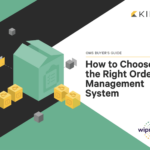When it comes to establishing this unification of online and offline channels, there are many questions to address around the issue of order orchestration logic. How do I synchronize my online listings with offline inventory? How do I determine how online orders are routed? How can I extend my product life cycle and reduce in-store price cuts by selling inventory online?
This article will outline common strategies for order orchestration so you can deliver frictionless customer journeys across online and offline channels while minimizing fulfillment costs, improving fulfillment efficiency, and optimizing order processes.
What is Order Orchestration?
Order orchestration refers to the process of coordinating and managing various activities and resources involved in fulfilling customer orders across the supply chain. It involves synchronizing and optimizing the flow of orders, inventory, and information to ensure efficient and timely order fulfillment.
Order orchestration encompasses a range of tasks, including order capture, inventory allocation, routing, fulfillment, and tracking. It integrates and coordinates activities across multiple channels, locations, and systems to achieve seamless and customer-centric order management.
In order orchestration, orders are captured from different sales channels, such as online stores, physical stores, or marketplaces. The system then determines the most appropriate fulfillment source based on factors like inventory availability, proximity to the customer, and operational capabilities.
Do You Need Order Orchestration?
You likely need an order orchestration tool if you have an online store and multiple distribution centers, including physical stores and warehouses. Order orchestration allows you to establish order-specific assignments and inventory visibility logic for routes.
Once you have an extensive network of stores, order orchestration will help you create seamless customer journeys from online to offline. “Order orchestration allows retailers to fulfill the customer’s order at the lowest possible cost while keeping margins and delivering a superior customer experience,” said Madhulika Saxena, Sr. Product Manager, Unified Commerce Platform at Kibo.
Benefits of Order Orchestration
Order orchestration plays a critical role in optimizing supply chain processes in retail by improving inventory management, enabling multi-channel fulfillment, streamlining logistics, enhancing visibility, facilitating efficient returns, and providing valuable data-driven insights.
With order orchestration, you can enhance customer satisfaction, improve in-store efficiencies by sending online orders to the stores best suited to handle their fulfillment, and reduce markdown by leveraging inventory. Other benefits of order orchestration include:
- Finding the best assignment locations for order items: Filter groups to retain desired locations based on assignment and visibility preferences.
- Customizing routing logic: Apply desired rules to specific groups and order states to satisfy the most complex routing requirements.
- Scheduling location downtime: Temporarily freeze locations based on unique requirements such as order thresholds and date ranges.
- Defining order split counts: Specify the desired number of allowed order splits by item or quantity to reduce shipping costs and increase customer satisfaction.
- Setting item-specific assignment logic: Define item-specific rules for goods that require special handling.
Building an Order Orchestration Strategy
For many retailers, several factors play into the order orchestration strategy. With an intelligent order orchestration engine, you can support complex fulfillment rules and prioritize by inventory turn, vendor partners, store locations, and more.
One retailer might prioritize its warehouse—which is well suited for picking, packing, and shipping orders—followed by nearby stores. Alternatively, another retailer might prioritize order fulfillment to its flagship store and use other stores as backup fulfillment sources.
Routing logic also lets retailers “turn off” or “turn on” various fulfillment options. For example, in the case of a natural disaster, you can prevent affected stores from being used as fulfillment centers until the crisis has passed.
Common Order Orchestration Rules:
Inventory Life to Date (LTD): Improves inventory turns and reduces markdowns by assigning orders to the locations with the slowest moving inventory. This can help reduce the need for discounting items on the shelf.
Control Split Shipments: Prioritizes scenarios that maintain single shipment or allows split shipments at line or quantity levels to minimize shipping costs. For example, if you use physical stores to fulfill orders, you could prioritize stores closest to the customer that can fulfill the complete order.
Cost-Base Optimization: Maximizes margins by considering multiple cost factors such as carrier costs, location-specific labor costs, and location overhead. For example, it may be cheaper to fulfill an order from a warehouse than a physical location depending on costs.
Assignment Throttling & Thresholds: Sets limits for orders, line items, or revenue volume by location to manage fulfillment capacity or regulate revenue distribution. For example, if you fulfill items from store locations, you could set a limit on quantity of an item purchased to ensure stores don’t run out of inventory.
Item Specific Assignment: Assigns orders that require special handling like assembly, personalization, or freight delivery to a specific fulfillment group or fulfiller location. For example, items of large size or high priced items may require special handling.
Geographic Proximity: Reduces shipping costs and customer delivery times by shipping from the location closest to the delivery address. For example, you could set a rule that prioritizes fulfillment from stores within 20 miles of the customer.
When leveraging an order management system with an intelligent order orchestration engine, such as Kibo’s Order Management System, you gain several key benefits for both your business and customers.
Optimized order orchestration enhances customer satisfaction by providing convenient fulfillment options and frictionless delivery experiences. The gained fulfillment efficiencies ensure you’re using inventory across your entire network — ultimately resulting in increased inventory turn, reduced markdowns, and optimized carrying costs that maximize profit margins.
Common Problems Order Orchestration Can Help With
Below are a couple of common hurdles that a modern order orchestration tool can help solve.
Problem: Your customers want more fulfillment choices than you currently offer (e.g., BOPIS, curbside pickup, same day delivery, etc.).
Solution: An order management solution that offers features like distributed order orchestration and order splitting can help you offer more fulfillment choices to your customers. By splitting orders and routing them to the nearest fulfillment location, you can offer BOPIS, curbside pickup, and same-day delivery.
Problem: You want to offer flexible, anytime fulfillment, but your current system can’t keep up.
Solution: Features like order splitting and intelligent order orchestration can ensure that orders are fulfilled from the nearest location. This will minimize shipping costs and get orders to customers faster.
If you’d like to learn more about Kibo’s Order Management System and its advanced order orchestration capabilities, schedule a demo.

Evaluate the Top OMS Vendors in the Market with The Forrester Wave: Order Management Systems, Q2 2023 Report

Step-By-Step Guide For Choosing an Order Management System

Editable OMS RFP Template for B2B and B2C Companies




